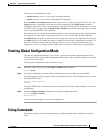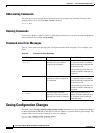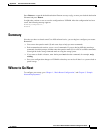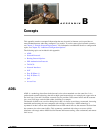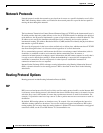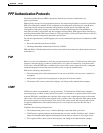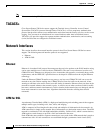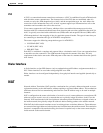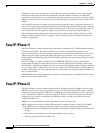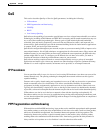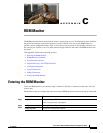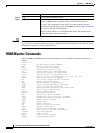
B-5
Cisco Secure Router 520 Series Software Configuration Guide
OL-14210-01
Appendix B Concepts
NAT
PVC
A PVC is a connection between remote hosts and routers. A PVC is established for each ATM end node
with which the router communicates. The characteristics of the PVC that are established when it is
created are set by the ATM adaptation layer (AAL) and the encapsulation type. An AAL defines the
conversion of user information into cells. An AAL segments upper-layer information into cells at the
transmitter and reassembles the cells at the receiver.
Cisco routers support the AAL5 format, which provides a streamlined data transport service that
functions with less overhead and affords better error detection and correction capabilities than AAL3/4.
AAL5 is typically associated with variable bit rate (VBR) traffic and unspecified bit rate (UBR) traffic.
ATM encapsulation is the wrapping of data in a particular protocol header. The type of router that you
are connecting to determines the type of ATM PVC encapsulation.
The routers support the following encapsulation types for ATM PVCs:
• LLC/SNAP (RFC 1483)
• VC-MUX (RFC 1483)
• PPP (RFC 2364)
Each PVC is considered a complete and separate link to a destination node. Users can encapsulate data
as needed across the connection. The ATM network disregards the contents of the data. The only
requirement is that data be sent to the ATM subsystem of the router in a manner that follows the specific
AAL format.
Dialer Interface
A dialer interface assigns PPP features (such as authentication and IP address assignment method) to a
PVC. Dialer interfaces are used when configuring PPP over ATM.
Dialer interfaces can be configured independently of any physical interface and applied dynamically as
needed.
NAT
Network Address Translation (NAT) provides a mechanism for a privately addressed network to access
registered networks, such as the Internet, without requiring a registered subnet address. This mechanism
eliminates the need for host renumbering and allows the same IP address range to be used in multiple
intranets.
NAT is configured on the router at the border of an inside network (a network that uses nonregistered IP
addresses) and an outside network (a network that uses a globally unique IP address; in this case, the
Internet). NAT translates the inside local addresses (the nonregistered IP addresses assigned to hosts on
the inside network) into globally unique IP addresses before sending packets to the outside network.
With NAT, the inside network continues to use its existing private or obsolete addresses. These addresses
are converted into legal addresses before packets are forwarded onto the outside network. The translation
function is compatible with standard routing; the feature is required only on the router connecting the
inside network to the outside domain.



